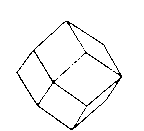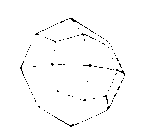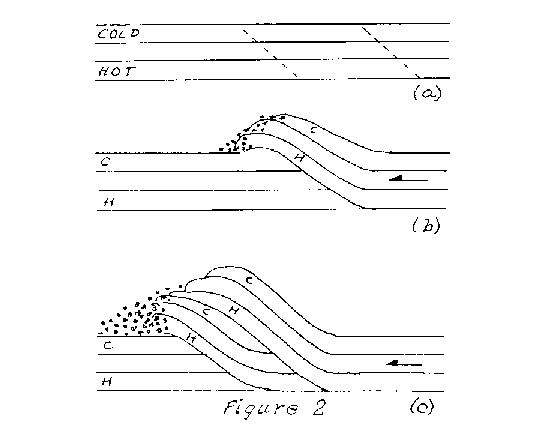|
Humberside Geologist No.
12
Discovering garnets along the
shore
including
some related musings
By Cyril Dutton
|
Humberside Geologist No.
12
Discovering garnets along the
shore
including
some related musings
By Cyril Dutton
Garnet crystals are always interesting. Mostly they are found sandwiched between layers of schist in a rock we call garnet mica schist. But now and then we may discover them in pebbles of garnet gneiss along the cast coast of England. There are many kinds of garnet, but the one we normally find is almandine garnet. Garnet gneiss is one of an interesting range of erratics deposited by the ice sheets during the Ice Age. Naturally, erratics can come from various places, so it can be fun working out their probable place of origin.

There was one type of rock that attracted my attention that afternoon. It was garnet gneiss. I suppose my interest was really a combination of three things: garnet crystals, gneisses, and the circumstances under which these rocks were formed. To quickly mention the elementary basics: we know rocks are classified as igneous, sedimentary, and metamorphic.
And both igneous and sedimentary rocks can be changed into metamorphic rocks by heat or pressure, or by a combination of both. I suppose this is what makes them more interesting for me. But there is an added dimension: it is how the theory of plate tectonics is involved.

This last ingredient, for me, has a special interest because it takes me beyond mere description of rocks or geological environments; it opens the possibilities of considering not only how a rock was metamorphosed, but also it tempts the imagination to consider the backcloth of associated tectonic circumstances and events. The kind of events that must have taken place both during and before the metamorphism of this specimen of garnet gneiss.
Garnet gneiss is a metabasite
It is now general knowledge that garnet gneiss is a metabasite; that is, it is metamorphosed from basic rocks. Rocks like basalt. The sea floors are composed of basalt. In the language of modem Earth Science, they are called MORB, which is short for Mid Ocean Ridge Basalt since this kind of basalt is formed at mid ocean ridges. It is an effusive activity. It depends upon the existence of a tensional regime in that part of the Earth's surface that allows hot molten basalt to reach the surface through small fissures or by rifting.
In this case, it is the rifting of the ocean floor, or an island associated with the mid ocean ridge. But it can also happen on land, on continental crust. So where was this erratic of garnet gneiss originally formed? On which ocean floor or on which island?
So the ovate-shaped, and rather heavy (i.e. dense) erratic of garnet gneiss which I found along the shore, must have originated as a basalt melt in a tectonic situation: Either at a mid ocean ridge in some ancient yet now nonexistent ocean, or erupted somewhere on land, or an island. And that existed many millions of years ago. Even its identity may no longer exist.
Wallking along the shore, such history can be pondered as rocks are inspected in the hand and dropped to return to the shore. So, from where did they come? One clue is that larvikite is also found along the same stretch of coastline. Of course, this is an easy one since it has to come from the region around Lavik in southern Norway.
But larvikite comes from part of an area known as the Oslo Rift. The problem with this is that it is of Mesozoic age whereas my specimen of garnet gneiss is clearly so much older. Indeed, it looks like a rock of Precambrian age. So this leads one to ponder the general area of southern Norway.
Having toured Norway, I remembered that the rocks of south Norway, south of the Caledonian mountains, are dated as of Mid to Late Proterozoic age. That is between 1750 Ma and 600 Ma. So this age-group appeared very promising. A study of some of my geological maps of the area show a terrain which has been very compressed, deformed and folded, resisting in slivers of different kinds of rock.
Many rocks have been metamorphosed, and there are many kinds of gneisses. In addition, there are a few granites, a little norite, and anorsite. Naturally, all the original Proterozoic landscape has been considerably eroded down from the initial height of the mountains. So, we can only see the roots of those old mountains. A quick glance at Figure 1 shows an example of how this ancient landmass appears today. (the letter G indicates granite while MB indicates metabasite.)
Environments where garnets are formed
Perhaps we should spend a few moments considering where garnets are formed globally. The garnet mineral seen in garnet gneiss as well as in garnet mica schist is known as almandite It is rich in iron and this is really no surprise since basic rocks like basalt are also rich in iron. And garnet gneiss is indeed a metabasite. But unlike our specimen, garnets found most frequently in the UK are metapelites like garnet-mica schist; this rock has a sedimentary origin. However, both those of sedimentary and igneous origin were metamorphosed in areas of regional metamorphism.
It is interesting that there are more than one kind of garnet. The garnet group includes six minerals, each with a different chemical formula. Unlike almandite which is iron-rich, andradite is a calcium rich garnet and is formed from impure limestone during contact metamorphism. It also contains iron. Grossularite has a higher content of aluminium while the iron content is low. This is formed from metamorphosed impure limestones and limy shales.
Pyrope, another kind of garnet, is rich in magnesium and is found with ferromagnesian minerals in silica poor rocks like the kimberlites of South Africa. Next we come to a very rare garnet, spessartite. It contains manganese and is found among manganese ores of metamorphic origin. Lastly, and rarest of them all, is uvarovite which contains chromium and is found among chromium ores of metamorphic origins.
Most members of my classes enjoyed the enrichment of a little chemistry. Or
perhaps I should use the word geochemistry. This is of particular interest when
considering the subject of garnets. Garnet crystals have an impure chemistry,
being composed of more than one kind of garnet. This is because the composition
of minerals can vary within certain limits. It is a sort of chemical
substitution of suitable elements. And obviously, the composition would depend
upon the chemical environment of the nearby rocks during their formation.
Minerals disappear and appear
Minerals are known to disappear and new minerals appear as metamorphism progresses. This in essence is how the piece of rock in my hand evolved. The original basalt did not need to contain garnets in order to be transformed into garnet gneiss. The almandite crystals were formed by chemical action during metamorphism as hot rich fluids migrated through the rock. Such transportation indicates the use of volatiles such as water and carbon dioxide. Volatiles are an essential part of the process of metamorphism.
During metamorphisim, the original basalt is helped by volatiles to form a new mineral, which is chlorite. It is known that both chlorite and garnet can exist together in thermodynamic equilibrium at a particular temperature. Thus reaction is sometimes set out as follows:
chlorite Þ garnet + water
But this reaction cannot be that simple. Chlorite contains both iron and
magnesium in its structure, and since the ratio of these can vary, it is
possible to find both iron-rich chlorite and magnesium-rich chlorite. With
increasing metamorphic grade, there can be a change in the ratio of iron and
magnesium in the chemical environment of the surrounding rock. As temperature
rises the chlorite is encouraged to shed some of its iron and in so doing
becomes more magnesium-rich. The release of iron can aid the formation of
almandite garnet So it would be more exact to write the reaction as follows:
iron-rich chlorite Þ magnesium-rich chlorite + garnet + water
In this simple example we see how Deformations take place within a solid rock
during metamorphisim. But you may be asking the question: What provides the
power or energy to make it happen? It will be obvious that for a rock or mineral
to give up an element and to accept another, some sort of energy must be
involved.
Concept of free energy
This energy is called 'free energy. It was a concept discovered by Josiah W. Gibbs (1839-1903) who recognized the nature of free energy in a rock system; he also understood that it will gradually become reduced during the activity of metamorphism.
So far we have just considered elements such as iron and magnesium in the rock. To understand what happens more easily one needs to accept that elements can exist as negative and positive ions. We know that every element actually has a number of electrons spinning about a nucleus. And one or more electrons may frequently be removed from, or even added to an element. In this state they are known as ions. This opens up a new field of view. No longer do we need to think of iron and magnesium as rigid, solid things. Instead we are freed to imagine them as electronic charges. That is what they really are. And ions with one or more electrons added or missing become negative or positive ions respectively.
So when we speak of free energy, it is now more easy to see this energy in terms of electric charges. Water and free energy combined cause ions to diffuse throughout the rock during the metamorphic process. This may happen in both a solid rock or in a melt. Solid-state diffusion may be intra-crystalline or inter-crystalline and the diffusion coefficients will differ. They differ between elements and can also differ with temperature changes. In any case, the process takes millions of years.
When new crystals are formed we call it a new phase; they depend upon
nucleation. And this nucleation depends upon enough free energy for the
formation of a critical nucleus. This also depends upon the rate of diffusion
through the matrix of the rock. This in turn relies upon two factors:
thermodynamic and kinetic. And it so happens that both are temperature
dependant.
Formation of a nappe
It is possible, during the tectonic process which can takes place during metamorphism, that areas of land can not only be compressed together, but can slide over and above other areas of land. This sort of event is called the formation of a nappe. Many nappes can form during mountain-building events.

There are examples to be seen in Scotland and central Norway which happened during the Caledonian orogeny. But we are considering what could have happened during the Mid to Late Paleozoic. A period of some 1,000 million years of continuious plate tectonic activity is more than ample time for the metamorphism of these rocks.
It is now known that all of Scandinavia has been subjected to, and formed by, plate tectonic processes over a long period of time. nfis activity has lasted since 1900 Ma, at least. So it is not surprising that there were both oceanic crust as well as continental crust, including all the other features which are part of the plate tectonic process.
'Ihe effect of nappe formation has a very relevant connection with our particular study of garnets because, when analysed under a powerful microscope, it can be seen that a garnet often has both a core and a rim of different chemistry. This may indicate two periods of metamorphism separated by an inactive period. We know that the Earth gets hotter with depth. So during nappe formation, when a slice of the Earth's crust is pushed above another area, this can have a profound efrect upon the process of metamorphism.
Consider its effect: the lower part of the nappe must be hotter than the top.
So, during and after nappe formation, this heat from the lower part of the top
slice tends to warn up the colder material below. (See Figure 2 where the hot
layer is marked H while the cold layer is marked C). as heat, plus the extra
pressure of the rocks above, could have the effect of increasing the grade of
metamorphism. In the case of a garnet crystal, the change could initiate a
second kind of garnet chemistry to form a rim on the original crystal core.
A nappe increases rate of metamorphism
As explained earlier, increased heat and pressure has an efrect upon the chemical changes taking place. And, for example, a garnet formed, say, with iron-rich ions, may now have added to it magnesium-rich ions to form its outer rim. Does the already-formed garnet crystal change in its composition? No. So the outer crystal will be of a different kind of garnet from the core garnet. And this is certainly not an infrequent happening.
Now, to consider the geological environments during the Mid to Late Proterozoic. Already, with my garnet gneiss pebble in my hand, and having studied the maps, I know that basalt existed in that region. Since plate tectonics is now known to have taken place during the Proterozoic age, it is qiute feasible that this basalt was produced at a mid ocean ridge and became part of a large ocean floor composed of basalt, often called oceanic crust And in course of time, as rock material was compressed and metamorphosed; it formed mountains either with or without one or more nappes.
I did mention the possibility of an island. But such a small amount of rock containing basalt would have become incorporated in the mass of various gneisses now displayed in southern Norway. Indeed, during the geological history of Scandinavia, many island arcs were moved toward the continent and accreted to it.
Copyright Humberside Geological Society 1999.
Return to Humberside Geologist Online